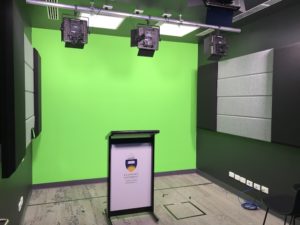 The Multimedia Recording Studio (‘the Studio’) provides a professional look to video recordings by ‘immersing’ the presenter into the recording (like TV news weather presenters standing in front of the weather map), making it more visually appealing to the audience.
The Multimedia Recording Studio (‘the Studio’) provides a professional look to video recordings by ‘immersing’ the presenter into the recording (like TV news weather presenters standing in front of the weather map), making it more visually appealing to the audience.
The Studio is a self-service video and audio recording studio at the Sturt campus available to all staff. The Studio offers green screen technology, where the presenters are filmed in front of a green wall (as per the picture) which is replaced with a backdrop of your choice – PowerPoint presentation, images, video, web sites (live) or even Skype or WebEx calls.
The room is easy to use and requires no post-processing of the video (other than simple trimming) as all the video mixing magic happens live during the recording.
Benefits of using the Studio
There are many benefits to providing online videos to students in their FLO sites. These include:
- content or instructions are provided to students for review prior to face-to-face sessions, allowing for more interactive and collaborative tutorial or lecture time
- recordings can be paused and reviewed as many times as needed, suiting different learning preferences and language competencies
- provides flexibility to students in accessing learning and attendance requirements
- provides rich visual media to explain concepts to students
- are reusable for future delivery of other subjects and to other audiences.
Uses for video in teaching and learning
Examples of videos that a topic coordinator might create and use in their FLO site:
- a ‘welcome to the topic’ short message (to personalise the site)
- an ‘introduction to the week’ – a summary of the requirements for the coming week
- explanation of requirements for the assessment of the topic
- required background subject content
- presentations to support understanding of the learning material
- clarification of concepts in an engaging way that otherwise often cause confusion
- explanation of topic content, other software or websites
- responses to a debate or reflection from a lecture or discussion forum posts
- mini lectures to replace hour-long lectures – chunked learning
- recordings of visiting lecturers or content experts at a time convenient to the visitor, which can also be used for future students or in other topics.
Tips for creating high-quality video recordings
There are several aspects to consider for creating high-quality video recordings. Here are some things to think about for effective use of video online:
- consider chunking content into segments shorter than a standard lecture. If a concept takes longer to explain, find natural breaks and create multiple videos
- motivate the audience by explaining what they will get out of watching the video
- the flow of your ‘message’ is an important part of a recording – make sure your presentation has a beginning, middle and end, explain the ‘why’ as well as the ‘what’, and if possible provide real examples to further support deeper learning
- consider adding questions or prompting reflections within your video. This gives the appearance of 1:1 dialogue, making the video more personal and possibly promoting deeper level thinking.
Using the Studio for the first time
We can arrange familiarisation sessions to discuss requirements regarding PowerPoint file styles, fonts, colours, clothing etc., and expected outcomes, including a brief training session on how to use the Studio. Tips and tricks are also available on the eLearning Gateway. You can submit a Service One (FLO) request to arrange a familiarisation and training session. The Studio can be booked using the Outlook calendar system (Room – U_STS_418_Multimedia_Recording_Studio).
If on-the-day support is needed, please include a note with your booking.
Contributed by Paul Stoll
eLearning & Media Support Officer – CILT

